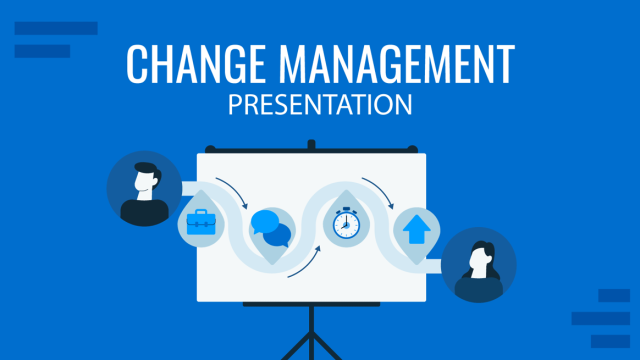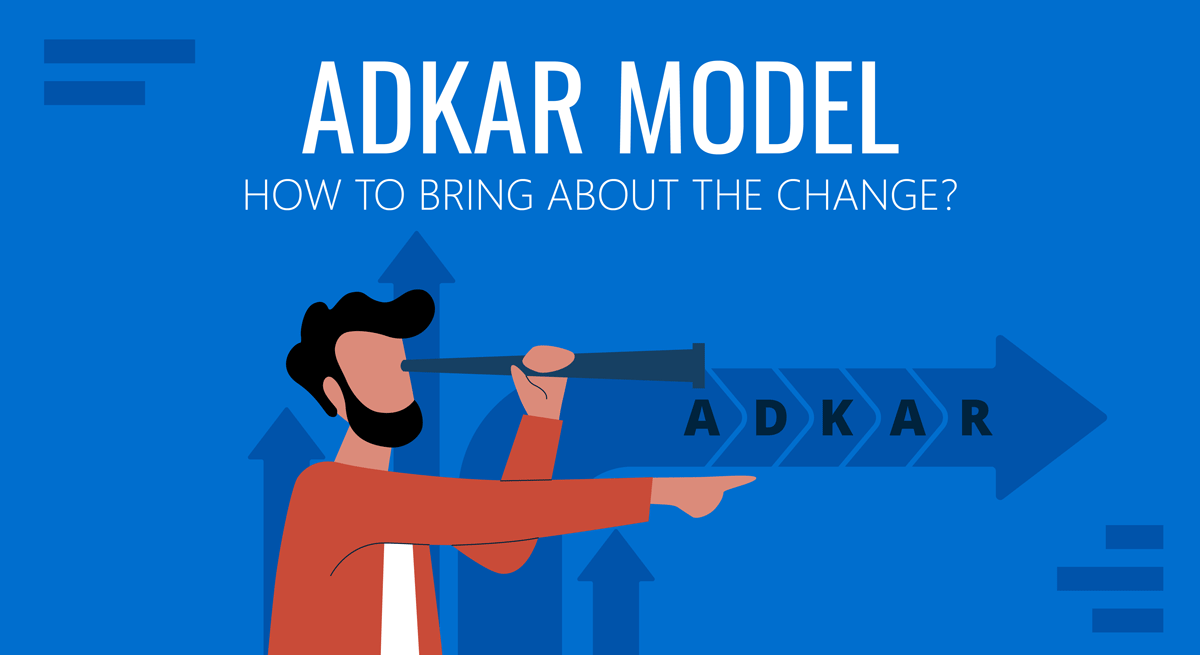
If you are bringing a change in your organization, the individual behaviors change, not the organization. Understanding how to bring about change personally is therefore essential to attaining the goals of any large-scale change. In this article, we focus on the significance of the ADKAR Model to examine the main actions, messages, and information needed to get team members through the personal shift of practicing effective change management.
What is the ADKAR Model?
After researching the change patterns of over 700 organizations, Prosci founder Jeff Hiatt developed the ADKAR model. Thousands of change leaders all over the world use this model. The ADKAR Model focuses on individual development, assisting people through a transition while addressing any roadblocks or barriers they may encounter in achieving organizational results.
ADKAR stands for:
- Awareness of the need for change
- Desire to support the change
- Knowledge on how to change
- Ability to showcase the changed skills and behavior
- Reinforcement to keep the change alive

Let’s go through these five building blocks in detail.
Awareness
The core building component of the ADKAR Model is “awareness of the need for change” and not only “awareness that a change is taking place.” Initially, this may appear to be a minor distinction, but it is significant and not only superficial.
As stated by the ADKAR model, raising awareness entails explaining both the nature of the change and why it is essential. It includes defining the business factors or possibilities that have led to the need for change clearly and concisely. It also means articulating why a change is required at this time and the dangers of not doing so. Awareness of the need for change can be built from communication, observable conditions, or catastrophic disasters.
Desire
Increased awareness does not translate into desire. Some change management professionals mistake focusing on the reasons for change rather than turning those reasons into individual and interpersonal driving factors. Such actions can be frustrating for employees.
Your change management strategies will necessitate the creative use of influential corporate executives as change sponsors and managers and supervisors as change coaches for employees. While there are many ways to sway a person’s decision to adapt to the changes, individuals must ultimately make this decision for themselves. Some of the strategies to foster employee desire may include a strong sponsorship alliance, proactive resistance management, Incentive schemes that are in sync with the change, coaches’ personal involvement, etc.
Knowledge
While gaining knowledge is an important aspect of change management, it is not the starting point for successful transformation. The third component in the ADKAR Model is Knowledge. There are two forms of knowledge in the context of change management. The first is knowledge on what to do during the change, and the second is knowledge on how to function well in the viable vision. To build the knowledge, you must follow various techniques such as mentoring, education and training or information accessibility.
Ability
Ability is the phase in a person’s changing process that genuinely changes. An individual’s ability is characterized by their ability to showcase the necessary modifications to attain ultimate anticipated performance results. Assisting your employees in successfully developing their abilities entails feedback, coaching or behavior role-modeling.
Reinforcement
It’s human nature to return to consistent ways. It’s difficult to make a change, but it’s even more difficult to persist in the change. Due to such reasons, reinforcement is an important part of a successful transformation strategy.
Reinforcement outlines the process and approaches that ensure the new way of doing things remains unchanged. Effective reinforcement may necessitate certain ways. They are recognition and rewards, celebrations, or mechanisms of accountability.
When you combine the above-explained ADKAR model steps, you have a transition process that meets the requirement to become aware of the change, and its importance, build the knowledge and abilities needed to accomplish the shift and reinforce those activities to avoid relapse.
The ADKAR model is an effective technique to implement change since it offers sufficient details about the process.
What is the key goal of the ADKAR model?
ADKAR model focuses on individual transformation, leading people through a specific change while addressing any bottlenecks or barriers. It enables leaders and change management teams to concentrate on what will contribute to individual change and attain organizational goals.
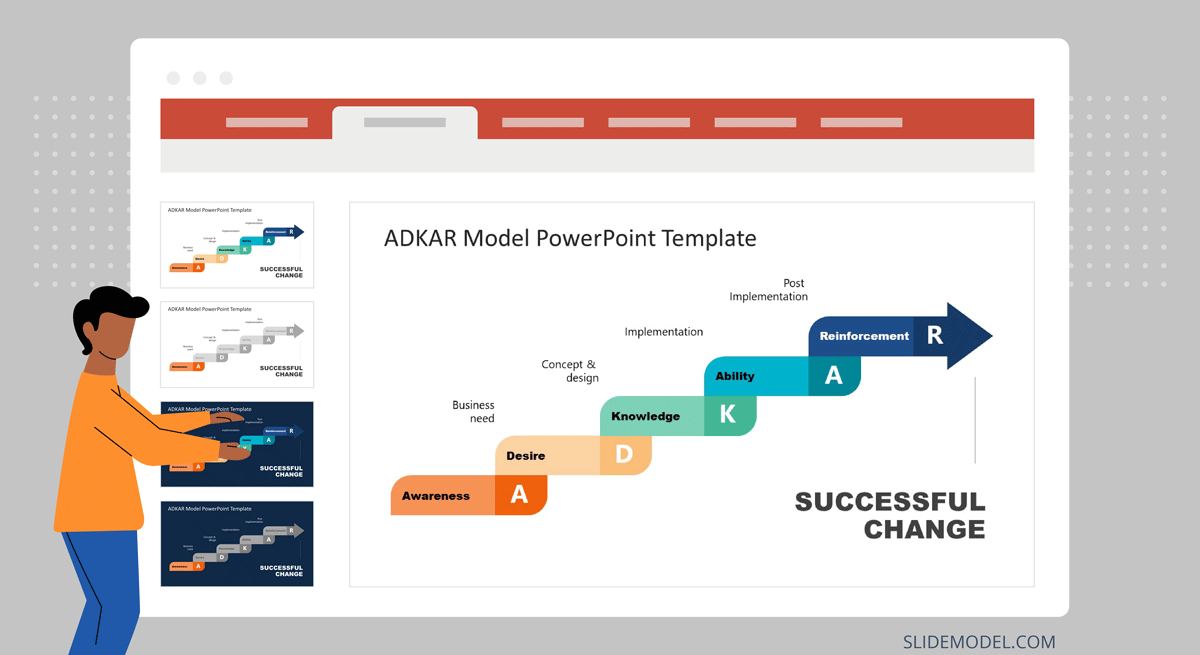
The model contributes to creating a change management strategy for the organization’s employees. The ADKAR model empowers you to deal with resistance to change and shorten the transition period.
Why use the ADKAR model?
While implementing change management in your organization, let’s emphasize the ADKAR model’s strengths and weaknesses.
If we discuss why to use the ADKAR model, numerous benefits make it appropriate to be used for the change management process. A few of ADKAR Model benefits are listed below.
Benefits of ADKAR Model
- Leaders can use this model to find flaws in their management processes as well as provide adequate training to their employees.
- Organizational performance and efficiency may be sustained and improved by considering the needs of the workforce.
- Change may be accomplished without disrupting daily operations, and employee performance improves when they feel supported.
- Employee acceptance towards positive change improves.
- Implementation of change facilitates a smooth transfer from the old to the new while preserving staff efficiency, morale and maintaining the business’s market presence.
- Using the ADKAR model minimizes the probability of a failed change.
Weaknesses of ADKAR Model
At the same time, some weaknesses can be noticed in the ADKAR model. The drawbacks are seen in the knowledge element, such as the lack of a foreordained guideline for the system’s implementation.
Another observed weakness is in the leader’s authority, where leaders lack a clear definition of authority and responsibility to make decisions. And finally, a deficiency in performance appraisal is not taken regularly, and the rewarding system is not linked to performance appraisal.
Pros and Cons of ADKAR Model
To add to its pro, ADKAR model targets how managers and leaders may assist employees in comprehending the changes, engaging with them, and implementing changes.
Because the model is goal-oriented, it is simple for managers to incorporate it into their organization’s structure and culture. It emphasizes making the employees satisfied with their job roles and responsibilities.
ADKAR model is designed for gradual change and has a specific focus. This strategy would probably not work if leaders wanted to make a macro-level change or weren’t clear how deep they needed to go with transitions. The ADKAR model overlooks the necessity for businesses to build a long-term vision for their change initiatives.
Because it focuses solely on the human side of change, the model is more suited for minor change proposals. This is insufficient to bring about large-scale change.
ADKAR Model application
Here you can find the ADKAR model example:
In changing human behavior
The ADKAR model works well for changing undesirable behavior in children.
Children must first recognize that what they are doing is incorrect. When an angry parent tells the child he is doing something wrong, he becomes conscious. Most children, however, will not be swayed by simply understanding it is bad. Their natural impulse is to push the limits and test the boundaries. Consequences are usually required, whether favorable or unfavorable. These effects influence the child’s motivation to change. The process, however, cannot end here. Children need a role model to learn what correct behavior looks like when they are motivated to change. They require examples to help them understand what is expected of them.
They’ll need to practise after that. Few individuals can change overnight; it is a long process that requires them to learn new abilities and build new habits. They require time to hone their ability to act in novel ways. Finally, youngsters need encouragement in order to maintain their positive behavior. This could take the form of positive reinforcement or other forms of compensation. You can see that all five steps of the ADKAR model were highlighted in this case.
Use of ADKAR in Implementing Team Nursing
When it comes to using the ADKAR model in healthcare, nothing explains it compared to its implementation in Team nursing. This Prosci ADKAR model provided support to the leaders and gave them tools to improve communication and help train care team members while implementing a change.
This change was a part of the team’s emergency planning and was in response to an increase in the COVID cases. There was a need to shift the primary nursing to team nursing affecting almost the entire nursing team. However with a relief of an action plan, it became possible for the team to move ahead with effective communication strategies specially designed to enable the change. These modes of communication included staff meetings, e-mail, town hall meetings,and weekly webinars.
A global pandemic added stress in the leaders which was unforeseen. At this time of significant uncertainty, it became necessary to rely on an evidence-based change management theory to give structure to the whole plan. Continuous evaluation was required to collect input and monitor morale levels, as well as identify hurdles, which was critical in navigating change. Scheduled team meetings at frequent intervals, such as daily/weekly, help keep everyone up to date on new information.
ADKAR model in a presentation
You can download the ADKAR model PPT template to show the entire 5-step transition plan.
The 100% editable change management model PPT template allow you to insert key elements of a change program.
When making a presentation or conducting a meeting regarding the anticipated changes within your firm, use this ADKAR model template in your presentation to make it more effective and convey the message clearly.
Alternatives to ADKAR Model
Change management models enable you to learn about best practices to utilize in a change project. Whether you choose one model or a combination of several, they can help you establish a better change management process. Some of the alternatives to ADKAR model can be:
1. Lewin’s change management model
A 3-step model to change behavior that is based on the process of melting and reshaping of an ice cube. It includes stages of “Unfreeze”, “Change” and “Refreeze” which means getting ready and accepting the upcoming change, implementing it and bringing out the required outcome to stick with, respectively. Here you can download Lewin’s Change Management Slide template for PowerPoint and Google Slides.
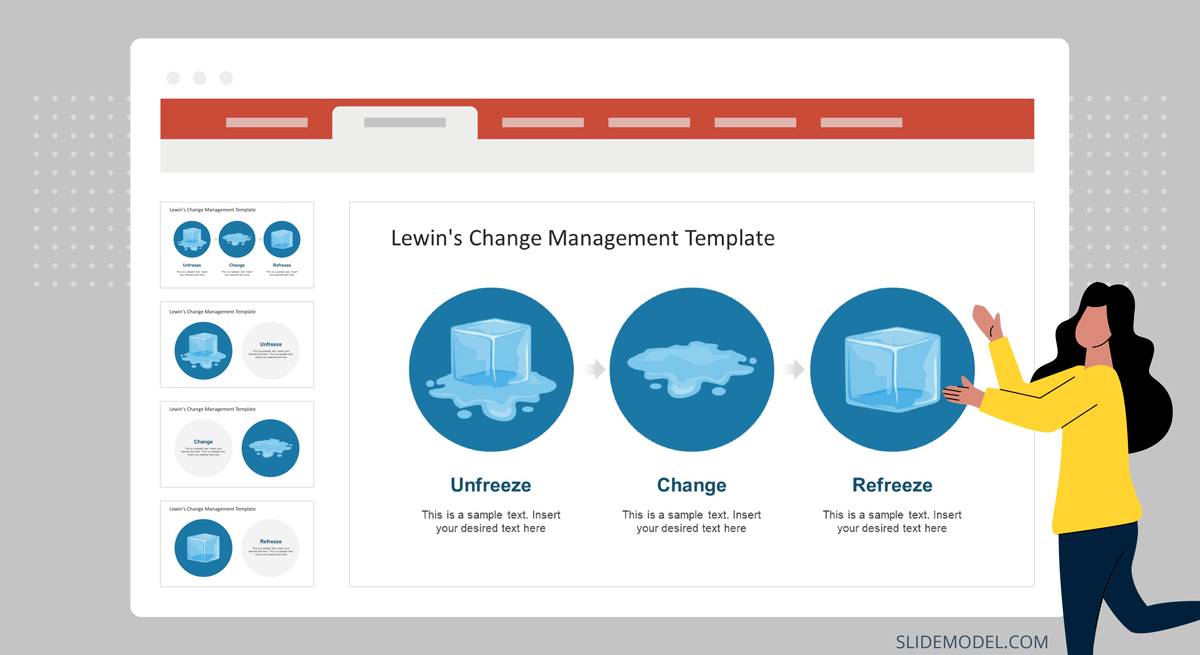
2. Kotter’s 8-step change model
Through employees’ faith and teamwork, Kotter’s change management process skillfully transforms potentially resistant individuals into receptive partners. This approach is a long-standing choice among change management models because it identifies the ultimate goal, involves everyone, and executes the impending changes collectively. Here you can download a Kotter 8-step editable PPT template.
3. Kubler-Ross change curve
Elisabeth Kubler-Ross devised a strategy based on how people process change using the 5 stages of grief. This model assists employees in coping with change by helping them deal with five stages that include Denial, Anger, Bargaining, Depression and Acceptance. Here you can download a Kubler-Ross PowerPoint template design.
4. McKinsey 7S model
This process works on the alignment of the leaders on the seven fundamental elements namely Strategy, Structure, Systems, Shared Values, Staff, Style and Skills for the effective implementation of change management.
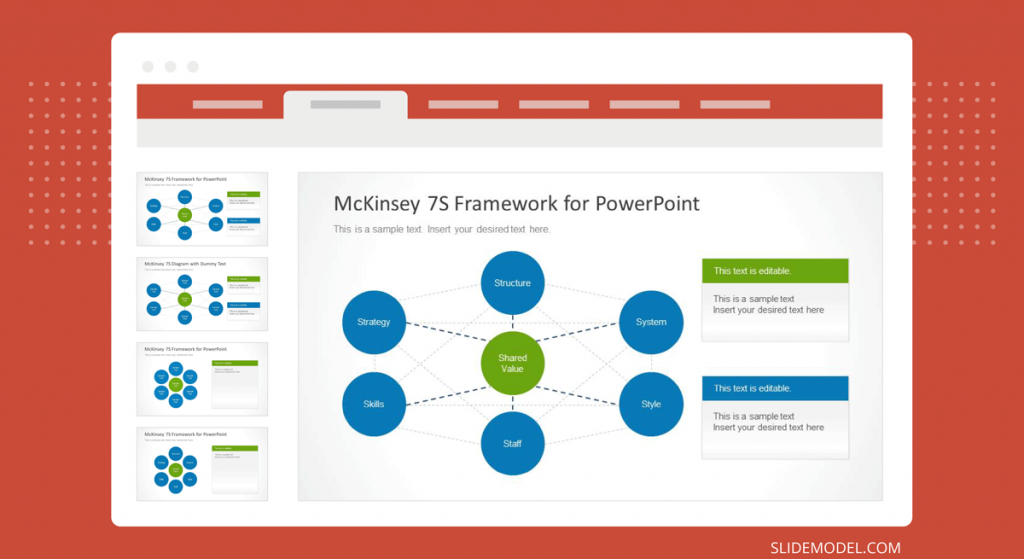
5. PDCA
The PDCA paradigm, which stands for Plan-Do-Check-Act, is a cyclical and repetitive method for ongoing progress and change. Also known as the Deming Wheel diagram, It guides businesses through a straightforward process of devising a strategy, testing the plan, implementing the plan, evaluating the plan’s success, and making the required modifications.
6. Bridges Transition Model
This is a people-centered model aimed at helping employees go through the transition. It includes stages of Ending, Losing and Letting go, Neutral zone and New beginnings.
Final words
To conclude, the ADKAR model’s objectives or outcomes are sequential as well as collaborative. Your change management team must acquire each component of the model individually, to apply and prolong the change and its wholesome benefits.

